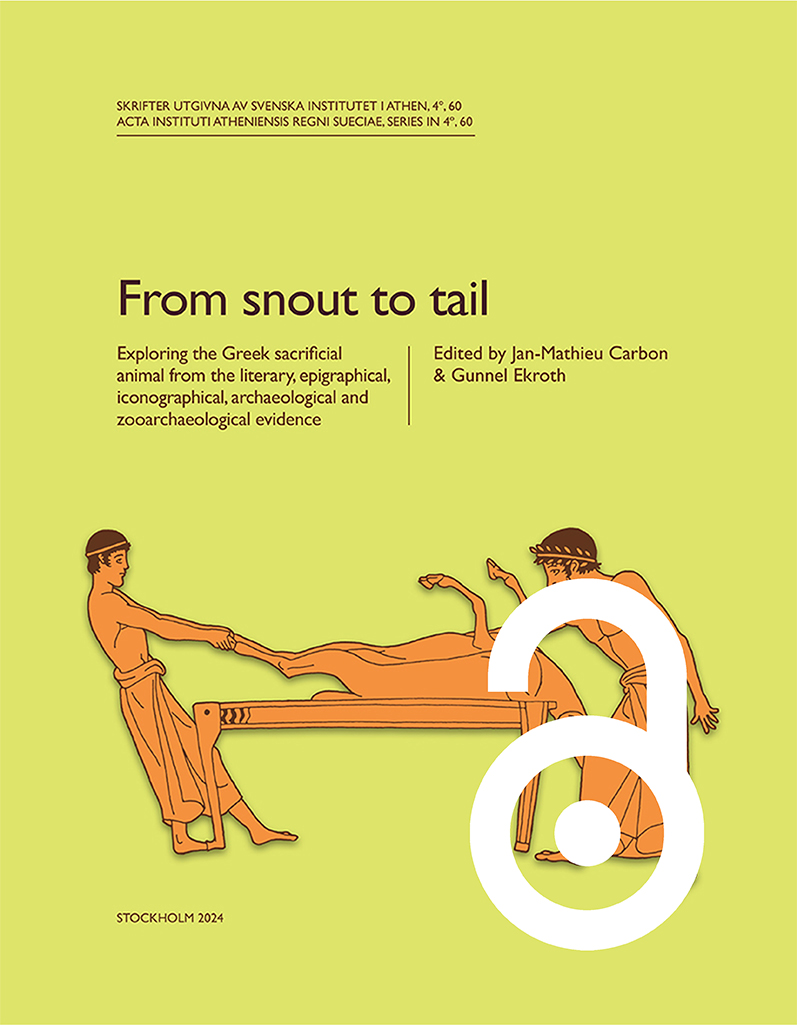Published by the Swedish Institute at Athens. Distributed by Eddy.se AB. All content is available with open access, use links below. From snout to tail. Exploring the Greek sacrificial animal from the literary, epigraphical, iconographical, archaeological, and zooarchaeological evidence Edited by Jan-Mathieu Carbon & Gunnel Ekroth https://doi.org/10.30549/actaath-4-60 Animal sacrifice fundamentally informed how the ancient Greeks defined themselves, their relation to the divine, and the structure of their society. Adopting an explicitly cross-disciplinary perspective, the present volume explores the practical execution and complex meaning of animal sacrifice within ancient Greek religion (c. 1000 BC–AD 200). The objective is twofold. First, to clarify in detail the use and meaning of body parts of the animal within sacrificial ritual. This involves a comprehensive study of ancient Greek terminology in texts and inscriptions, representations on pottery and reliefs, and animal bones found in sanctuaries. Second, to encourage the use and integration of the full spectrum of ancient evidence in the exploration of Greek sacrificial rituals, which is a prerequisite for understanding the complex use and meaning of Greek animal sacrifice. Twelve contributions by experts on the literary, epigraphical, iconographical, archaeological and zooarchaeological evidence for Greek animal sacrifice explore the treatment of legs, including feet and…
Opuscula is published by the Swedish Institutes at Athens and Rome, with the aid of a grant from the Swedish Research Council. Distributed by Eddy.se AB. View journal at ERIH PLUS. All content available with open access. Animals in the sanctuary. Bird bones and eggshell By Dale Serjeantson (University of Southampton, United Kingdom) Abstract Excavations at the Sanctuary of Poseidon at Kalaureia and the application of a systematic soil sampling and water flotation programme led to the collection of a moderate amount for bird bones and eggshell fragments. Their dating in the first millennium BC and their association with cult renders them a significant addition to the extant bird remains record in Greece. In this paper the bird and egg remains are presented in detail by chronological phase and by feature, they are compared with other contemporary assemblages of bird remains, and some commentary is offered on their significance. Bibliographical information Dale Serjeantson, ’Animals in the sanctuary. Bird bones and eggshell’, Opuscula. Annual of the Swedish Institutes at Athens and Rome (OpAthRom) 12, Stockholm 2019, 223–231. ISSN: 2000-0898. ISBN: 978-91-977799-1-3. https://doi.org/10.30549/opathrom-12-05 Bioarchaeological remains from the Sanctuary of Poseidon at Kalaureia The section on the bioarchaeological remains from the Sanctuary of…
Opuscula is published by the Swedish Institutes at Athens and Rome, with the aid of a grant from the Swedish Research Council. Distributed by Eddy.se AB. View journal at ERIH PLUS. All content available with open access. Symbolic connotations of animals at early Middle Helladic Asine. A comparative study of the animal bones from the settlement and its graves By Stella Macheridis Abstract This paper is a contribution to the zooarchaeological research on animals or animal parts found in human graves during the Middle Bronze Age in Greece. The animal bones from the early Middle Helladic settlement (MH I-II, c. 2100–1800 BC) and contemporary burials at Asine are presented. The goal is to compare the animal bones from the settlement with those from the burials, in terms of species composition and body part distribution. Through this comparison, this paper aims to discuss any symbolic connotations of bone waste from everyday-life practices. The results show that the most common domesticates from settlement contexts, pig, sheep/goat and cattle, also appear to be the most abundant animals deposited in the early MH graves at Asine. This is consistent with mortuary data from other sites on the Peloponnese, especially Lerna. The pig was most…



